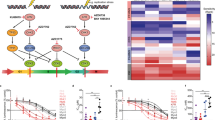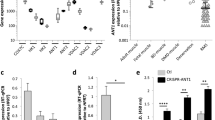Abstract
Alveolar rhabdomyosarcoma is an aggressive pediatric cancer exhibiting skeletal-muscle differentiation. New therapeutic targets are required to improve the dismal prognosis for invasive or metastatic alveolar rhabdomyosarcoma. Protein kinase C iota (PKCι) has been shown to have an important role in tumorigenesis of many cancers, but little is known about its role in rhabdomyosarcoma. Our gene-expression studies in human tumor samples revealed overexpression of PRKCI. We confirmed overexpression of PKCι at the mRNA and protein levels using our conditional mouse model that authentically recapitulates the progression of rhabdomyosarcoma in humans. Inhibition of Prkci by RNA interference resulted in a dramatic decrease in anchorage-independent colony formation. Interestingly, treatment of primary cell cultures using aurothiomalate (ATM), which is a gold-containing classical anti-rheumatic agent and a PKCι-specific inhibitor, resulted in decreased interaction between PKCι and Par6, decreased Rac1 activity and reduced cell viability at clinically relevant concentrations. Moreover, co-treatment with ATM and vincristine (VCR), a microtubule inhibitor currently used in rhabdomyosarcoma treatment regimens, resulted in a combination index of 0.470–0.793 through cooperative accumulation of non-proliferative multinuclear cells in the G2/M phase, indicating that these two drugs synergize. For in vivo tumor growth inhibition studies, ATM demonstrated a trend toward enhanced VCR sensitivity. Overall, these results suggest that PKCι is functionally important in alveolar rhabdomyosarcoma anchorage-independent growth and tumor-cell proliferation and that combination therapy with ATM and microtubule inhibitors holds promise for the treatment of alveolar rhabdomyosarcoma.
This is a preview of subscription content, access via your institution
Access options
Subscribe to this journal
Receive 50 print issues and online access
$259.00 per year
only $5.18 per issue
Buy this article
- Purchase on Springer Link
- Instant access to full article PDF
Prices may be subject to local taxes which are calculated during checkout







Similar content being viewed by others
References
Anderson J, Gordon A, Pritchard-Jones K, Shipley J . Genes, chromosomes, and rhabdomyosarcoma. Genes Chromosomes Cancer 1999; 26: 275–285.
Hayes-Jordan A, Andrassy R . Rhabdomyosarcoma in children. Curr Opin Pediatr 2009; 21: 373–378.
Arndt CA, Crist WM . Common musculoskeletal tumors of childhood and adolescence. N Engl J Med 1999; 341: 342–352.
Breneman JC, Lyden E, Pappo AS, Link MP, Anderson JR, Parham DM et al. Prognostic factors and clinical outcomes in children and adolescents with metastatic rhabdomyosarcoma--a report from the Intergroup Rhabdomyosarcoma Study IV. J Clin Oncol 2003; 21: 78–84.
Wachtel M, Schafer BW . Targets for cancer therapy in childhood sarcomas. Cancer Treat Rev 2010; 36: 318–327.
Mackay HJ, Twelves CJ . Targeting the protein kinase C family: are we there yet? Nat Rev Cancer 2007; 7: 554–562.
Griner EM, Kazanietz MG . Protein kinase C and other diacylglycerol effectors in cancer. Nat Rev Cancer 2007; 7: 281–294.
Fields AP, Murray NR . Protein kinase C isozymes as therapeutic targets for treatment of human cancers. Adv Enzyme Regul 2008; 48: 166–178.
Ali AS, Ali S, El-Rayes BF, Philip PA, Sarkar FH . Exploitation of protein kinase C: a useful target for cancer therapy. Cancer Treat Rev 2009; 35: 1–8.
Chen L, Burger RA, Zaunbrecher GM, Cheng H, Lincoln AJ, Mallarino MC et al. Protein kinase C isoform expression and activity alter paclitaxel resistance in vitro. Gynecol Oncol 1999; 72: 171–179.
Murray NR, Fields AP . Atypical protein kinase C iota protects human leukemia cells against drug-induced apoptosis. J Biol Chem 1997; 272: 27521–27524.
Svensson K, Larsson C . A protein kinase Cbeta inhibitor attenuates multidrug resistance of neuroblastoma cells. BMC Cancer 2003; 3: 10.
Fields AP, Regala RP . Protein kinase C iota: human oncogene, prognostic marker and therapeutic target. Pharmacol Res 2007; 55: 487–497.
Regala RP, Weems C, Jamieson L, Khoor A, Edell ES, Lohse CM et al. Atypical protein kinase C iota is an oncogene in human non-small cell lung cancer. Cancer Res 2005; 65: 8905–8911.
Ishiguro H, Akimoto K, Nagashima Y, Kojima Y, Sasaki T, Ishiguro-Imagawa Y et al. aPKClambda/iota promotes growth of prostate cancer cells in an autocrine manner through transcriptional activation of interleukin-6. Proc Natl Acad Sci USA 2009; 106: 16369–16374.
Regala RP, Davis RK, Kunz A, Khoor A, Leitges M, Fields AP . Atypical protein kinase C{iota} is required for bronchioalveolar stem cell expansion and lung tumorigenesis. Cancer Res 2009; 69: 7603–7611.
Regala RP, Thompson EA, Fields AP . Atypical protein kinase C iota expression and aurothiomalate sensitivity in human lung cancer cells. Cancer Res 2008; 68: 5888–5895.
Regala RP, Weems C, Jamieson L, Copland JA, Thompson EA, Fields AP . Atypical protein kinase C iota plays a critical role in human lung cancer cell growth and tumorigenicity. J Biol Chem 2005; 280: 31109–31115.
Scotti ML, Bamlet WR, Smyrk TC, Fields AP, Murray NR . Protein kinase C iota is required for pancreatic cancer cell transformed growth and tumorigenesis. Cancer Res 2010; 70: 2064–2074.
Win HY, Acevedo-Duncan M . Atypical protein kinase C phosphorylates IKKalphabeta in transformed non-malignant and malignant prostate cell survival. Cancer Lett 2008; 270: 302–311.
Win HY, Acevedo-Duncan M . Role of protein kinase C-iota in transformed non-malignant RWPE-1 cells and androgen-independent prostate carcinoma DU-145 cells. Cell Prolif 2009; 42: 182–194.
Zhang L, Huang J, Yang N, Liang S, Barchetti A, Giannakakis A et al. Integrative genomic analysis of protein kinase C (PKC) family identifies PKCiota as a biomarker and potential oncogene in ovarian carcinoma. Cancer Res 2006; 66: 4627–4635.
Murray NR, Jamieson L, Yu W, Zhang J, Gokmen-Polar Y, Sier D et al. Protein kinase C iota is required for Ras transformation and colon carcinogenesis in vivo. J Cell Biol 2004; 164: 797–802.
Stallings-Mann M, Jamieson L, Regala RP, Weems C, Murray NR, Fields AP . A novel small-molecule inhibitor of protein kinase Ciota blocks transformed growth of non-small-cell lung cancer cells. Cancer Res 2006; 66: 1767–1774.
Erdogan E, Lamark T, Stallings-Mann M, Lee J, Pellecchia M, Thompson EA et al. Aurothiomalate inhibits transformed growth by targeting the PB1 domain of protein kinase Ciota. J Biol Chem 2006; 281: 28450–28459.
Etienne-Manneville S, Hall A . Cell polarity: Par6, aPKC and cytoskeletal crosstalk. Curr Opin Cell Biol 2003; 15: 67–72.
Murray NR, Kalari KR, Fields AP . Protein kinase Ciota expression and oncogenic signaling mechanisms in cancer. J Cell Physiol 2011; 226: 879–887.
Cen L, Arnoczky KJ, Hsieh FC, Lin HJ, Qualman SJ, Yu S et al. Phosphorylation profiles of protein kinases in alveolar and embryonal rhabdomyosarcoma. Mod Pathol 2007; 20: 936–946.
Amstutz R, Wachtel M, Troxler H, Kleinert P, Ebauer M, Haneke T et al. Phosphorylation regulates transcriptional activity of PAX3/FKHR and reveals novel therapeutic possibilities. Cancer Res 2008; 68: 3767–3776.
Fields AP, Frederick LA, Regala RP . Targeting the oncogenic protein kinase Ciota signalling pathway for the treatment of cancer. Biochem Soc Trans 2007; 35 (Part 5): 996–1000.
Maroto B, Ye MB, von Lohneysen K, Schnelzer A, Knaus UG . P21-activated kinase is required for mitotic progression and regulates Plk1. Oncogene 2008; 27: 4900–4908.
Wittmann T, Bokoch GM, Waterman-Storer CM . Regulation of microtubule destabilizing activity of Op18/stathmin downstream of Rac1. J Biol Chem 2004; 279: 6196–6203.
Woodcock SA, Rushton HJ, Castaneda-Saucedo E, Myant K, White GR, Blyth K et al. Tiam1-Rac signaling counteracts Eg5 during bipolar spindle assembly to facilitate chromosome congression. Curr Biol 2010; 20: 669–675.
Blocka KL, Paulus HE, Furst DE . Clinical pharmacokinetics of oral and injectable gold compounds. Clin Pharmacokinet 1986; 11: 133–143.
Nelson RL . The comparative clinical pharmacology and pharmacokinetics of vindesine, vincristine, and vinblastine in human patients with cancer. Med Pediatr Oncol 1982; 10: 115–127.
Houghton JA, Houghton PJ, Green AA . Chemotherapy of childhood rhabdomyosarcomas growing as xenografts in immune-deprived mice. Cancer Res 1982; 42: 535–539.
Thompson J, George EO, Poquette CA, Cheshire PJ, Richmond LB, de Graaf SS et al. Synergy of topotecan in combination with vincristine for treatment of pediatric solid tumor xenografts. Clin Cancer Res 1999; 5: 3617–3631.
Sorensen PH, Lynch JC, Qualman SJ, Tirabosco R, Lim JF, Maurer HM et al. PAX3-FKHR and PAX7-FKHR gene fusions are prognostic indicators in alveolar rhabdomyosarcoma: a report from the childrenss oncology group. J Clin Oncol 2002; 20: 2672–2679.
Bouche M, Zappelli F, Polimeni M, Adamo S, Wetsel WC, Senni MI et al. Rapid activation and down-regulation of protein kinase C alpha in 12-O-Tetradecanoylphorbol-13-acetate-induced differentiation of human rhabdomyosarcoma cells. Cell Growth Differ 1995; 6: 845–852.
Germani A, Fusco C, Martinotti S, Musaro A, Molinaro M, Zani BM . TPA-induced differentiation of human rhabdomyosarcoma cells involves dephosphorylation and nuclear accumulation of mutant P53. Biochem Biophys Res Commun 1994; 202: 17–24.
Liu LN, Dias P, Houghton PJ . Mutation of Thr115 in MyoD positively regulates function in murine fibroblasts and human rhabdomyosarcoma cells. Cell Growth Differ 1998; 9: 699–711.
Thimmaiah KN, Easton JB, Houghton PJ . Protection from rapamycin-induced apoptosis by insulin-like growth factor-I is partially dependent on protein kinase C signaling. Cancer Res 2010; 70: 2000–2009.
Sundberg C, Thodeti CK, Kveiborg M, Larsson C, Parker P, Albrechtsen R et al. Regulation of ADAM12 cell-surface expression by protein kinase C epsilon. J Biol Chem 2004; 279: 51601–51611.
Limatola C, Barabino B, Nista A, Santoni A . Interleukin 1-beta-induced protein kinase C-zeta activation is mimicked by exogenous phospholipase D. Biochem J 1997; 321 (Part 2): 497–501.
Jordan MA, Thrower D, Wilson L . Mechanism of inhibition of cell proliferation by Vinca alkaloids. Cancer Res 1991; 51: 2212–2222.
Tennyson GS, Burbach BJ, Lane BP . Reproductive potential of vincristine-treated multinucleate carcinoma cells. Cancer Treat Rep 1983; 67: 1113–1114.
Keller C, Arenkiel BR, Coffin CM, El-Bardeesy N, DePinho RA, Capecchi MR . Alveolar rhabdomyosarcomas in conditional Pax3:Fkhr mice: cooperativity of Ink4a/ARF and Trp53 loss of function. Genes Dev 2004; 18: 2614–2626.
Keller C, Hansen MS, Coffin CM, Capecchi MR . Pax3:Fkhr interferes with embryonic Pax3 and Pax7 function: implications for alveolar rhabdomyosarcoma cell of origin. Genes Dev 2004; 18: 2608–2613.
Nishijo K, Chen QR, Zhang L, McCleish AT, Rodriguez A, Cho MJ et al. Credentialing a preclinical mouse model of alveolar rhabdomyosarcoma. Cancer Res 2009; 69: 2902–2911.
Rubin BP, Nishijo K, Chen HI, Yi X, Schuetze DP, Pal R et al. Evidence for an unanticipated relationship between undifferentiated pleomorphic sarcoma and embryonal rhabdomyosarcoma. Cancer Cell 2011; 19: 177–191.
Acknowledgements
This work was supported by NIH/NCI Grant 1R01CA133229-04 and -05 awarded to CK, NIH/NCI Grant 4R01CA081436-13 and the V Foundation for Cancer Research awarded to APF. Human tissue samples were provided by the Pediatric Cooperative Human Tissue network, which is funded by the National Cancer Institute. The Developmental Studies Hybridoma Bank is developed under the auspices of the NICHD and maintained by the University of Iowa, Iowa City, IA, USA.
Author information
Authors and Affiliations
Corresponding author
Ethics declarations
Competing interests
The authors declare no conflict of interest.
Additional information
Supplementary Information accompanies the paper on the Oncogene website
Supplementary information
Rights and permissions
About this article
Cite this article
Kikuchi, K., Soundararajan, A., Zarzabal, L. et al. Protein kinase C iota as a therapeutic target in alveolar rhabdomyosarcoma. Oncogene 32, 286–295 (2013). https://doi.org/10.1038/onc.2012.46
Received:
Revised:
Accepted:
Published:
Issue Date:
DOI: https://doi.org/10.1038/onc.2012.46
Keywords
This article is cited by
-
MicroRNAs as the critical regulators of autophagy-mediated cisplatin response in tumor cells
Cancer Cell International (2023)
-
circPARD3 drives malignant progression and chemoresistance of laryngeal squamous cell carcinoma by inhibiting autophagy through the PRKCI-Akt-mTOR pathway
Molecular Cancer (2020)
-
Chemoradiation impairs myofiber hypertrophic growth in a pediatric tumor model
Scientific Reports (2020)
-
Measuring the lactate-to-creatine ratio via 1H NMR spectroscopy can be used to noninvasively evaluate apoptosis in glioma cells after X-ray irradiation
Cellular & Molecular Biology Letters (2018)
-
A proof-of-concept trial of protein kinase C iota inhibition with auranofin for the paclitaxel-induced acute pain syndrome
Supportive Care in Cancer (2017)



